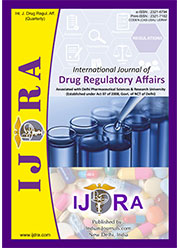Navigating the Regulatory Maze: Compliance Strategies for GHK-Cu in the Global Cosmetic Industry
Abstract
Introduction: This study aims to explore the complex regulatory frameworks governing the use of GHK-Cu (Copper-binding tripeptide complex) in cosmetic formulations across various global markets. It evaluates the challenges manufacturers face in ensuring compliance while maintaining product efficacy and safety.
Scope: The analysis draws from international cosmetic regulations, scientific literature on GHK-Cu, and case studies across the EU, USA, Asia-Pacific, and other markets. Official publications by regulatory bodies and peer-reviewed journals were also referenced.
Objective: The article reviews scientific studies validating GHK-Cu's safety and effectiveness, regulatory guidelines from jurisdictions such as the FDA, EU Commission, CDSCO (India), and MFDS (South Korea), and industry reports concerning compliance and market entry.
Summary of Contents: GHK-Cu, a naturally occurring peptide with anti-aging and regenerative properties, is widely incorporated in skin care. However, its regulatory status varies significantly worldwide. While the EU demands extensive pre-market safety assessments, the USA adopts a more lenient but scrutinized post-market model. Asian countries exhibit diverse approaches. The article discusses labeling, marketing claims, clinical validation, and the economic burden of compliance. It also presents strategic solutions, including early regulatory engagement, transparent labeling, sustainable sourcing, and emerging testing technologies.
Conclusion: Navigating international compliance for GHK-Cu-based products requires a multifaceted, proactive approach that integrates scientific validation, regulatory intelligence, and market-specific strategies. Harmonization efforts and stakeholder collaboration are essential to foster innovation and ensure consumer safety.
Downloads
References
2. Pingou P, Parla A, Kabir A, Furton KG, Samanidou V, Papageorgiou S, et al. Quantitation of Copper Tripeptide in Cosmetics via Fabric Phase Sorptive Extraction Combined with Zwitterionic Hydrophilic Interaction Liquid Chromatography and UV/Vis Detection. Separations [Internet]. 2024 [cited 2025 May 15]; 11(10). Available from: https://www.researchgate.net/publication/384918933_Quantitation_of_Copper_Tripeptide_in_Cosmetics_via_Fabric_Phase_Sorptive_Extraction_Combined_with_Zwitterionic_Hydrophilic_Interaction_Liquid_Chromatography_and_UVVis_Detection
3. Regulation - 655/2013 - EN - EUR-Lex [Internet] [cited 2025 May 15]. Available from: https://eur-lex.europa.eu/eli/reg/2013/655/oj/eng
4. Kończyk J, Myga-Nowak M, Michalski R, Janoszka K. Electromigration Techniques in the Analysis of Selected Cosmetic Ingredients: A Review. Molecules [Internet]. 2025 [cited 2025 May 15]; 30(1):161. Available from: https://pmc.ncbi.nlm.nih.gov/articles/PMC11721023/
5. Errante F, Ledwoń P, Latajka R, Rovero P, Papini AM. Cosmeceutical Peptides in the Framework of Sustainable Wellness Economy. Front Chem [Internet]. 2020 [cited 2025 May 15]; 8:572923. Available from: https://pmc.ncbi.nlm.nih.gov/articles/PMC7662462/
6. Singh H, Sharma K, Raj V, Majeed J. Snail extract for skin: A review of uses, projections, and limitations. Skin Res Technol. 2024;30(2):e12345. Available from:https://pubmed.ncbi.nlm.nih.gov/38429932
7. Wang M, Zhang L, Zheng L, Shi J, Gao H, He C, et al. Research Progress on Evaluating the Effectiveness and Safety of Transdermal Absorption of Cosmetics. Cosmetics [Internet]. 2024 [cited 2025 May 15];11(6):217. Available from: https://www.mdpi.com/2079-9284/11/6/217
8. Zaky AA, Simal-Gandara J, Eun J-B, Shim J-H, Abd El-Aty AM. Bioactivities, applications, safety, and health benefits of bioactive peptides from food and by-products: A review. Front Nutr [Internet]. 2022 [cited 2025 May 15]; 8:815640. Available from: https://www.frontiersin.org/journals/nutrition/articles/10.3389/fnut.2021.815640/full
9. View of Congress Proceedings of Pharmacy Updates 2023 [Internet]. [cited 2025 May 15]. Available from: https://journals.sbmu.ac.ir/acta/article/view/41757/31613
10. Li Y, Lu Y, Zhao Y, Zhang N, Zhang Y, Fu Y. Deciphering the Wound-Healing Potential of Collagen Peptides and the Molecular Mechanisms: A Review. J Agric Food Chem [Internet]. 2024 [cited 2025 May 15]. Available from: /doi/pdf/10.1021/acs.jafc.4c02960
11. Boniamin M, Sohag MSU, Ahmad MS, Hasan MR, Sumi SY, Bari QI, et al. Protective effects of nutrients and antioxidant-rich seed oil and sprouted seed oil of Benincasa hispida against formaldehyde-induced hepatic and renal damage. Pharmacol Res Chinese Med [Internet]. 2024 [cited 2025 May 15]; 13:100555. Available from: https://www.sciencedirect.com/science/article/pii/S2667142524001970
12. Tapfumaneyi T, Mutsando B, Mpofu E, Maponga CC. Recent advances and future prospectives of topical and transdermal delivery systems. Front Drug Deliv. 2022;2:957732. Available from: https://www.frontiersin.org/articles/10.3389/fddev.2022.957732/full
13. Bhavsar J, Kasture K, Salvi BV, Shende P. Strategies for transportation of peptides across the skin for treatment of multiple diseases. Ther Deliv [Internet]. 2024 [cited 2025 May 15]. Available from: https://www.tandfonline.com/doi/abs/10.1080/20415990.2024.2411943
14. Liu M, Chen S, Zhang Z, Li H, Sun G, Yin N, et al. Anti-ageing peptides and proteins for topical applications: a review. Pharm Dev Technol [Internet]. 2022 [cited 2025 May 15]; 27(1):108–25. Available from: https://www.tandfonline.com/doi/abs/10.1080/10837450.2021.2023569
15. Horatti L, Kumar DNR, Rayapati A. A systematic review on the treatment of androgenetic alopecia. IP Indian J Clin Exp Dermatol. 2022;8(3):141–146. Available from: https://doi.org/10.18231/j.ijced.2022.031
16. Kakkar P, Wadhwa N. Skin microbiome: current target for cosmeceuticals. Karbala Int J Mod Sci. 2024 [cited 2025 May 15]; 10(3):10. Available from: https://kijoms.uokerbala.edu.iq/home/vol10/iss3/10/
17. Li Y, Zhang J, Li X, et al. Molecular mechanisms of aging and anti-aging strategies. Cell Commun Signal. 2024;22(1):1–17. Available from: https://doi:10.1186/s12964-024-01663-1.
18. Rehan F, Zhang M, Fang J, Greish K. Therapeutic applications of nanomedicine: recent developments and future perspectives. Molecules. 2024;29(9):2073. Available from: https://doi:10.3390/molecules29092073.
19. Muttenthaler M, King GF, Adams DJ, Alewood PF. Trends in peptide drug discovery. Nat Rev Drug Discov 2021 204 [Internet]. 2021 [cited 2025 May 15]; 20(4):309–25. Available from: https://www.nature.com/articles/s41573-020-00135-8

This work is licensed under a Creative Commons Attribution-NonCommercial 4.0 International License.
The International Journal of Drug Regulatory affairs require a formal written transfer of copyright from the author(s) for each article published. We therefore ask you to complete and return this form, retaining a copy for your records. Your cooperation is essential and appreciated. Any delay will result in a delay in publication.
I/we have read and agree with the terms and conditions stated Page 2 of this agreement and I/we hereby confirm the transfer of all copyrights in and relating to the above-named manuscript, in all forms and media, now or hereafter known, to the International Journal of Drug Regulatory affairs, effective from the date stated below. I/we acknowledge that the IJDRA is relying on this agreement in publishing the above-named manuscript. However, this agreement will be null and void if the manuscript is not published in the IJDRA.
Download link for COPYRIGHT FORM







